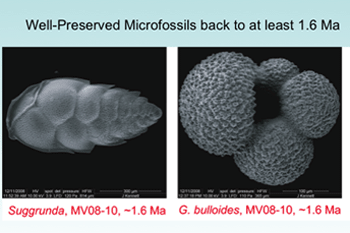Research Interests
Research largely deals with earth system history during the Cenozoic,
including the Pleistocene, based on the analyses of the deep-sea
sedimentary record and the uplifted marine record on land.
A variety of paleoenvironmental proxies are used (stable isotopes,
fossils, sediments) to reconstruct paleoclimatic, oceanographic
and biotic changes in the sedimentary record.

Jim Kennett
Of greatest interest is to help develop better understanding
of the past global environmental/ paleoclimatic changes and
to evaluate the dynamic interactions that constantly occurred
in the past between the several global spheres (lithosphere,
ocean, atmosphere, cryosphere, and biosphere).

Jim Kennett
The kinds of questions we think about include the following:
What is the climate evolution of the polar regions?
When and how did the major ice sheets form?
How have changes in ocean circulation affected global climate
development?
How did the oceans circulate during times of global warming?
How tight are the linkages between climate change and
thermohaline circulation?
How abruptly do climate and oceans switch between different states
and what processes drive these changes?
 How has the global climate changed during the classic ice-age period
and how has this affected North American climate?
What is the history and causes of abrupt climate changes?
What is the origin of climatic behavior, at brief and longer intervals
in the recent ice-age period?
How and when has instability of methane hydrates affected
abrupt climatic change?
What is the record of biological evolution in the oceans and
how does this help with the understanding of biotic
evolutionary processes?
Data related to this and other questions are generated
in light stable isotope mass spectrometry and micropaleontological
and sedimentary laboratories.
How has the global climate changed during the classic ice-age period
and how has this affected North American climate?
What is the history and causes of abrupt climate changes?
What is the origin of climatic behavior, at brief and longer intervals
in the recent ice-age period?
How and when has instability of methane hydrates affected
abrupt climatic change?
What is the record of biological evolution in the oceans and
how does this help with the understanding of biotic
evolutionary processes?
Data related to this and other questions are generated
in light stable isotope mass spectrometry and micropaleontological
and sedimentary laboratories.

Recent work has addressed the potential effects of cosmic impact
in the latest Pleistocene on climate change, major terrestrial
extinctions and human shifts.